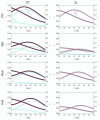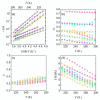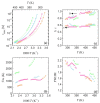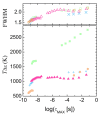Broadband Dielectric Spectroscopy Study of Biobased Poly(alkylene 2,5-furanoate)s' Molecular Dynamics
- PMID: 32560215
- PMCID: PMC7361705
- DOI: 10.3390/polym12061355
Broadband Dielectric Spectroscopy Study of Biobased Poly(alkylene 2,5-furanoate)s' Molecular Dynamics
Abstract
Poly(2,5-alkylene furanoate)s are bio-based, smart, and innovative polymers that are considered the most promising materials to replace oil-based plastics. These polymers can be synthesized using ecofriendly approaches, starting from renewable sources, and result into final products with properties comparable and even better than those presented by their terephthalic counterparts. In this work, we present the molecular dynamics of four 100% bio-based poly(alkylene 2,5-furanoate)s, using broadband dielectric spectroscopy measurements that covered a wide temperature and frequency range. We unveiled complex local relaxations, characterized by the simultaneous presence of two components, which were dependent on thermal treatment. The segmental relaxation showed relaxation times and strengths depending on the glycolic subunit length, which were furthermore confirmed by high-frequency experiments in the molten region of the polymers. Our results allowed determining structure-property relations that are able to provide further understanding about the excellent barrier properties of poly(alkylene 2,5-furanoate)s. In addition, we provide results of high industrial interest during polymer processing for possible industrial applications of poly(alkylene furanoate)s.
Keywords: 2,5-furandicarboxylic acid; bio-based polymers; broadband dielectric spectroscopy; molecular dynamics; poly(2,5-alkylene furanoate)s.
Conflict of interest statement
The authors declare no conflict of interest.
Figures






Similar articles
-
Exploring Next-Generation Engineering Bioplastics: Poly(alkylene furanoate)/Poly(alkylene terephthalate) (PAF/PAT) Blends.Polymers (Basel). 2019 Mar 23;11(3):556. doi: 10.3390/polym11030556. Polymers (Basel). 2019. PMID: 30960540 Free PMC article.
-
Synthesis and Characterization of Bio-Based Polyesters: Poly(2-methyl-1,3-propylene-2,5-furanoate), Poly(isosorbide-2,5-furanoate), Poly(1,4-cyclohexanedimethylene-2,5-furanoate).Materials (Basel). 2017 Jul 14;10(7):801. doi: 10.3390/ma10070801. Materials (Basel). 2017. PMID: 28773158 Free PMC article.
-
Towards High Molecular Weight Furan-Based Polyesters: Solid State Polymerization Study of Bio-Based Poly(Propylene Furanoate) and Poly(Butylene Furanoate).Materials (Basel). 2020 Oct 30;13(21):4880. doi: 10.3390/ma13214880. Materials (Basel). 2020. PMID: 33143165 Free PMC article.
-
Biotechnological production and high potential of furan-based renewable monomers and polymers.Biotechnol Adv. 2021 May-Jun;48:107707. doi: 10.1016/j.biotechadv.2021.107707. Epub 2021 Feb 22. Biotechnol Adv. 2021. PMID: 33631186 Review.
-
Enzymatic hydrolysis of poly(ethylene furanoate).J Biotechnol. 2016 Oct 10;235:47-53. doi: 10.1016/j.jbiotec.2016.02.006. Epub 2016 Feb 17. J Biotechnol. 2016. PMID: 26854948 Review.
Cited by
-
Solid-State Polymerization of Poly(Ethylene Furanoate) Biobased Polyester, III: Extended Study on Effect of Catalyst Type on Molecular Weight Increase.Polymers (Basel). 2019 Mar 6;11(3):438. doi: 10.3390/polym11030438. Polymers (Basel). 2019. PMID: 30960422 Free PMC article.
-
Fabrication of Poly(ethylene furanoate)/Silver and Titanium Dioxide Nanocomposites with Improved Thermal and Antimicrobial Properties.Materials (Basel). 2024 Apr 1;17(7):1606. doi: 10.3390/ma17071606. Materials (Basel). 2024. PMID: 38612120 Free PMC article.
-
Design and Characterization of Aromatic Copolyesters Containing Furan and Isophthalic Rings with Suitable Properties for Vascular Tissue Engineering.Int J Mol Sci. 2025 Jul 4;26(13):6470. doi: 10.3390/ijms26136470. Int J Mol Sci. 2025. PMID: 40650245 Free PMC article.
-
Action of Mechanical Forces on Polymerization and Polymers.Polymers (Basel). 2022 Feb 3;14(3):604. doi: 10.3390/polym14030604. Polymers (Basel). 2022. PMID: 35160593 Free PMC article. Review.
-
On the Selective Enzymatic Recycling of Poly(pentamethylene 2,5-furanoate)/Poly(lactic acid) Blends and Multiblock Copolymers.ACS Sustain Chem Eng. 2023 Jun 16;11(26):9751-9760. doi: 10.1021/acssuschemeng.3c01796. eCollection 2023 Jul 3. ACS Sustain Chem Eng. 2023. PMID: 37425282 Free PMC article.
References
-
- Kremer F., Schönhals A. Broadband Dielectric Spectroscopy. Springer; Berlin/Heidelberg, Germany: 2003.
-
- Bozell J.J., Petersen G.R. Technology development for the production of biobased products from biorefinery carbohydrates—The US Department of Energy’s “Top 10” revisited. Green Chem. 2010;12:539–554. doi: 10.1039/b922014c. - DOI
Grants and funding
LinkOut - more resources
Full Text Sources

